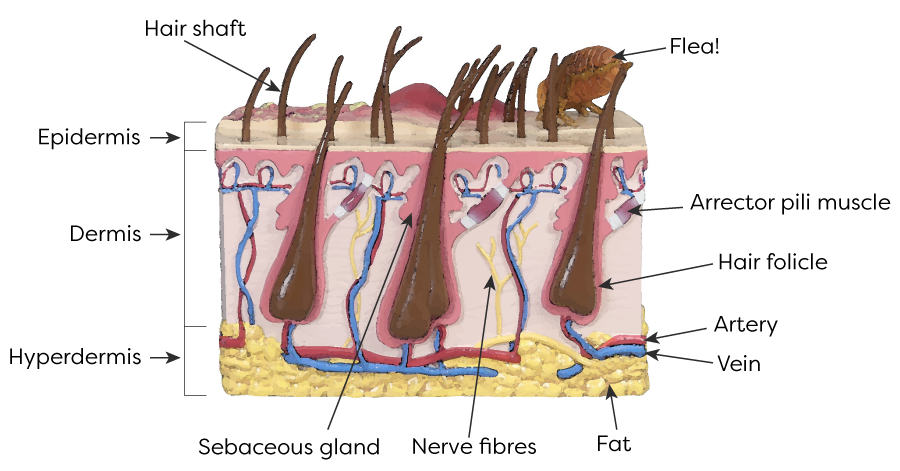Skin conditions are one of the most common issues we see across our clinics and can cause significant discomfort for your pet. We usually see an increase in cases during the warmer months from Spring though summer when allergies are more prone, and our pets are spending more time outside. Skin problems can also indicate an underlying health condition that might not have previously been diagnosed.
Best Mates Members don’t forget to book your best mate in for their FREE Skin Health Check.
Dogs can suffer from mild to severe skin conditions, many of which require veterinary intervention before they get any worse. If skin disease is left untreated the condition can often become more complicated. An allergic skin reaction, for example, may become secondarily infected with bacteria, or a bacterial infection may then become infected with yeast. Some of the most common skin disorders in dogs include bacterial skin infections, environmental allergies and parasite allergies.
So let’s start with the symptoms that something might be up with your dogs skin and while we are at it take a closer look at the underlying structure.
Symptoms of skin conditions
Itching is one of the most obvious signs your dog has a skin condition, but it’soften difficult to determine exactly what’s irritating your dog without a veterinary examination. While it is quite normal for a dog to occasionally itch, just like a person may occasionally scratch their skin, frequent or prolonged itching is a tell-tale sign of something going on.
Other common symptoms of a skin or hair coat condition include:
- Excessive scaling, either in fine particles (dandruff) or sheets (coarse scale)
- Dry, rough patches of flaking skin
- Greasy accumulation of skin cells on the skin’s surface
- Excessive itchiness, evident by scratching, rubbing, rolling, licking, chewing, head shaking, or scooting
- Hair follicles blocked up with oil and skin cells
- Hair loss (alopecia)
- Moist, red sores under the hair coat
- Pimple-like pustules on the skin
- Crusted skin
- Red or irritated skin
- Scabs
- Hot spots, or localised areas your dog keeps itching/biting
- Infected hair follicles
- Hair standing on end
- Seeping of blood or pus
- Swelling or ulcerated skin
- Unpleasant odour
- Irritated areas secreting pus
Five Facts About Itchy Skin

Itching is not a disease
It’s a clinical sign, and every effort should be made to find the cause, not just treat. Skin diseases can be very challenging to diagnose and treat. This may result in some tests that seem a bit confusing to you:
- Skin scrapings
- Skin biopsies
- Blood tests to check for hormonal diseases (such as thyroid deficiency)
- Allergy testing and trial treatments
If you’re confused by any of the testing, ask your Fur Life Vet to clarify.

Itching may not be a skin problem at all
There are a myriad of things that can initiate itching or “pruritus.” Causes can be primary skin diseases or secondary to problems not directly associated with the skin.

Parasites that can cause itching are not always visible to the naked eye

Itching caused by infection may have varied clinical appearances

Itching caused by allergies can be topical, dietary or inhaled
Tip
Check your pet regularly for symptoms.
- Take notes or keep a diary
- Try and identify when your dog started to show symptoms
- Note if the reaction appears to be at a specific time or after a specific activity such as eating.
- Do symptoms appear at certain times of the year like Spring or Autumn?
- Does your dog itch after you have cleaned the house or worked in the garden?
- The information you provide your Fur Life Vet is vital to reaching an accurate and fast diagnosis.
The most common canine skin conditions

Environmental allergies
A sudden onset of itching particularly to the face, feet, chest and stomach can indicate an environmental allergy, triggered as and when your dog is in contact with the cause of irritation.
This particular type of allergy in dogs is called ‘Atopy’ and is similar to how people have hay fever – except that dogs show it by having irritated, itchy skin rather than watery eyes and sneezing.
A blood test can help diagnose whether your pet is allergic to grass, dust mites and pollens, which are some of the most common things dogs are allergic to. Treating environmental allergies can be difficult and in the most severe cases involve shampoo’s, tablets and injections. Over recent years, there have been some new drugs which have revolutionised the care of dogs with this disease and a combination of treatments can help ease your pet’s symptoms effectively.
Food allergies
Increased itching often involving the face, feet, ears and anus are signs of a potential dog food allergy. Dogs can develop food allergies from the type of protein consumed as part of their diet such as beef, eggs, chicken and dairy, although it can be anything in the diet such as wheat or even vegetables.
Like humans, who experience food intolerances, pets must go through an elimination process for 8-12 weeks to rule out any causes of the allergies. Your vet will advise you step by step on this type of treatment. It is vital that you refrain from introducing your dog to any of the suspected allergens during the elimination process to ensure an effective treatment process.
Fleas and Ticks
Fleas and ticks affect your dog’s skin by biting and sucking their blood. Flea saliva enters the body and can cause an allergic response which irritates your pet’s skin, causing them to itch profusely. Pets suffering from a severe parasite allergy experience symptoms of inflamed, red skin, will often scratch and dogs may chew at their fur to relieve the itching. In extreme conditions, their fur can fall out in patches.
Fleas are tiny parasites which can survive in our carpets and bedding, which is why it’s so important to vacuum regularly, wash your pet’s bed and make sure they’re up-to-date with their preventative treatments to kill off any bugs.
Yeast infections
Warm areas on a dog’s body attract yeast infections, which love to grow in hard to reach areas, such as the ear canal, in between your dog’s toes, groin and perineum. Dogs with exccessive wrinkles can also suffer from yeast infections between the folds of skin.
The skin can thicken, causing your dog to itch and bite at the infected area. Yeast infections can discolour the skin and tend to smell unpleasant: a topical cream, washes and tablets will help to relieve the symptoms and help cure the infected site.
Mange
Mange is a severe skin condition caused by several species of mites that live on the dog’s hair and skin.
There are 2 main types of mange: one caused by the demodex mite ‘demodectic mange’, which tends to affect dogs under one year old, older dogs or pets with another underlying condition.
Sarcoptic mange caused by sarcoptes mites, which is an intensely itchy condition and is often first seen on the dog’s ears. Symptoms of mange include hair loss on the face and legs, along with severe itching and redness around the affected areas.
As with fleas and ticks, if your pet has mange, wash their bedding and make sure any other animals avoid contact with this pet. Mange is diagnosed by the vet looking at a sample of some of the skin under the microscope. Treatment includes tablets and dedicated shampoos to kill the mite, ease the itching and inflammation – in fact, some of the flea and worm products that vets prescribe can also protect against mange.
Dandruff
Like humans, dogs can get dandruff or ‘scurff’ and dry skin; this can be a sign of an underlying problem, like an infection. Some dogs are prone to having dry skin, particularly in winter and it may be affected by their diet; high-quality sources of protein, omega 3 and 6 fatty acids can all help keep the coat healthy.
Simple cases of dandruff are normally easy to treat with shampoos but the vet will want to check there is nothing underlying.





Recent Comments